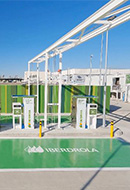Hydrogen Day 2024
Unveiling the energy future on World Hydrogen Day
Every October 8, scientists and engineers around the world celebrate World Hydrogen and Fuel Cell Day, an opportunity to highlight the importance of this chemical element and its role in the transition to a cleaner and more equitable energy future. Fully aligned with this objective, at Iberdrola we are working to accelerate the clean production of green hydrogen and to find ways of safe and sustainable storage.

The date of World Hydrogen Day was chosen for a reason that is both numerical and curious: the atomic weight of this chemical element is 1.008, which in turn can be represented as 10/08 on the calendar. The US Fuel Cell and Hydrogen Energy Association (FCHEA) created this event in 2015 to recognise the relevance of clean hydrogen, which is produced with zero or near-zero emissions, and this its tenth celebration plans to feature a variety of activities and events.
The potential of hydrogen is enormous, firstly because it is the most abundant chemical element in the universe. It is the main component of stars and gaseous planets, but it is rarely found in its pure state on Earth. It is often combined with other elements such as oxygen in water (H2O) or carbon in hydrocarbons (CH4, C2H6, etc.). To obtain renewable hydrogen, it is necessary to extract it from the water molecule (H2O) through the process of electrolysis.
Renewable hydrogen is emerging as a key energy vector for the energy transition with a wide range of potential applications. It is the solution to decarbonise so-called "hard to abate" sectors. For technological reasons, it is difficult to electrify the consumption of industrial sectors such as ammonia or fertilisers, refining or the heavy mobility sector, where green hydrogen will be key to achieving decarbonisation, starting to replace those that already use grey hydrogen, and over time new uses will be introduced, either for hydrogen or for its derivatives: ammonia or green methanol.
Green hydrogen will drive the growth of renewable energy, as its production requires electricity from renewable energy sources, making it a further driver in the energy transition to a more decarbonised economy independent of imported fossil fuels.
Types of hydrogen and the advantages of each of them
Hydrogen can be classified into several types based on the feedstock required to produce it and the CO2 emissions it can generate. In addition, each category of hydrogen has a number of advantages and disadvantages compared to the others:
Green hydrogen
Green hydrogen is produced by electrolysis of water using electricity generated from renewable energy. The result is used to replace grey hydrogen in industrial processes or to decarbonise heavy mobility. It is, therefore, a process free of pollutant emissions throughout its value chain.
Green hydrogen does not emit CO2 in its production.
Blue hydrogen
The process of obtaining blue hydrogen involves the use of hydrocarbons. From compounds such as methane, for example, a chemical process called "reforming" is carried out to obtain hydrogen on the one hand, and carbon dioxide on the other. Carbon capture and storage techniques are then applied to reduce the emissions released into the atmosphere. The result is hydrogen which, although not produced directly from renewable energy sources, is considered cleaner than grey hydrogen.
This process can be produced using infrastructures as widespread as those for natural gas. However, it does not fully reduce greenhouse gas emissions, still relies on natural gas as a feedstock and requires CO2 capture infrastructure.
Every tonne of blue hydrogen produced emits 1 tonne of CO2.
Grey hydrogen
Grey hydrogen comes from fossil fuels: it is produced from natural gas or other light hydrocarbons such as methane or liquefied petroleum gases by reforming processes. It is used in the refining and fertiliser industries. Although it is obtained in a similar way to blue hydrogen, carbon dioxide emissions are not controlled so pollution is higher.
Each tonne of grey hydrogen produced emits 9 tonnes of CO2.
Currently, 99 % of the hydrogen consumed in Spain is grey hydrogen, with CO2 emissions.
Other types of hydrogen
In addition to these types, there are additional colours for classifying hydrogen.
-
Brown or black hydrogen: produced through the gasification of coal.
-
Turquoise hydrogen: obtained by gasification of hydrocarbons through a pyrolysis reaction, a thermal degradation at very high temperatures in the absence of oxygen.
-
Pink hydrogen: uses electricity generated in a nuclear power plant for electrolysis.
-
Violet hydrogen: follows the same process combined with heat and thermochemical reactions.
-
Yellow hydrogen: the electricity used for electrolysis comes from mixed sources (from renewable energies to fossil fuels).

Metanol verde
Discover the fuel that can accelerate the energy transition of maritime transport.

Hydrogen stations
Hydropower plants are essential for the promotion of sustainable mobility. But what are they and how do they work?
What is the future of hydrogen in the energy sector?
Hydrogen will account for up to 12 % of global energy use by 2050, according to the International Renewable Energy Agency (IRENA). In addition, the organisation estimates that the cost of hydrogen installations can decrease by 40 to 80 % in the long term. This, together with the falling cost of renewable energies and the development of more mature electrolysis equipment, may open the door for this technology to become increasingly cost-effective.
Future plans for hydrogen
As green hydrogen technology matures —supported by technological innovation, international collaboration and favourable policies and regulations— it will take on more and more strategic uses. Some of the most prominent future application plans include:
![]() Decarbonisation of industry
Decarbonisation of industry
One of the main objectives of the energy transition is to reduce carbon emissions from industrial sectors. Green hydrogen will be used in industry to replace hydrogen from fossil fuels in processes such as the chemical, refining and heat-intensive industries.
![]() Sustainable mobility
Sustainable mobility
Heavy transport is another of the key sectors to be decarbonised using green hydrogen where, by means of a hydrogen fuel cell, a carbon-free heavy mobility alternative is offered.
Iberdrola is a pioneer in decarbonising this sector with the Barcelona Green Hydrogen Project, the first hydrogen plant for public use in Spain for fleet decarbonisation, operational from January 2022.

Projects where hydrogen is one of the main energy sources: success stories
Green hydrogen infrastructures are becoming increasingly widespread. At Iberdrola, we are leading the global development of green hydrogen with projects in countries such as Spain, Brazil, the United Kingdom, Australia and the United States to respond to the electrification and decarbonisation needs of sectors such as industry and heavy transport. The goal is to develop an industry that covers the entire value chain of this energy vector.
One of our major projects is the construction of the largest renewable hydrogen plant in Europe, with 20 MW of electrolyser, located in Puertollano (Ciudad Real). This project is already operational and produces green hydrogen to replace grey hydrogen for the manufacture of green fertilisers and ammonia.
In Spain, Iberdrola has announced the construction of the largest green ammonia plant to be located in Huelva. This ammonia will be produced from green hydrogen. This plant will be viable thanks to European funds and will produce 100,000 t/year with an investment of 750 MEur. It will be the first plant to start up the green hydrogen maritime corridor between the south and north of Europe, which will help to boost the decarbonisation of industry in the Netherlands and Germany.
In Australia, we are developing a hydrogen and green methanol production plant at Bell Bay in northern Tasmania together with hydrogen developer ABEL Energy. The project, called Bell Bay Powerfuels, is backed by the Australian government and is expected to produce 300,000 tonnes of green methanol in its second phase, with the aim of decarbonising the marine sector and other niche applications.
In the United Kingdom, our subsidiary ScottishPower has secured funding from the UK government to develop two green hydrogen projects, which will be the first industrial-scale green hydrogen plants in that country. The hydrogen produced will be used to supply emissions-free fuel in high-temperature industrial processes and to replace fossil fuels in heavy transport. In 2024, the company has also signed a deal with aircraft manufacturer ZeroAvia to explore the development of green hydrogen supply solutions in the UK aviation sector.
We are also exploring new applications such as green ammonia. In 2023, we signed the largest framework agreement for this product in Europe to date with Trammo for the sale and purchase of up to 100,000 tonnes per year from 2026. In addition, we have a partnership with Sempra Infrastructure for the joint development of hydrogen and green ammonia projects in the United States powered by renewable sources.







